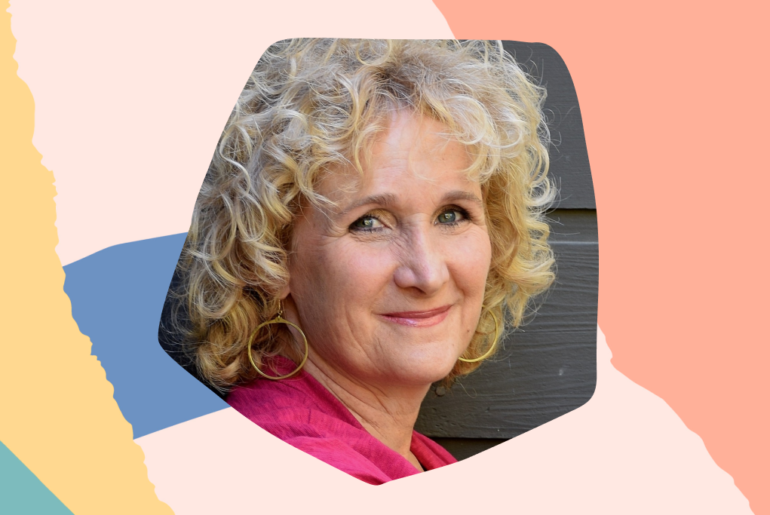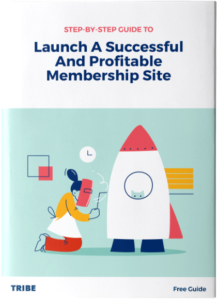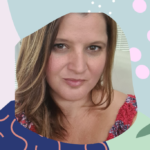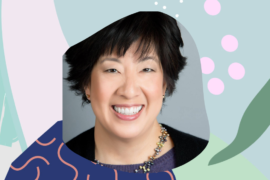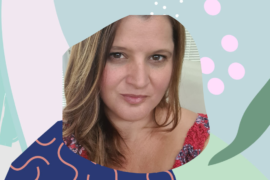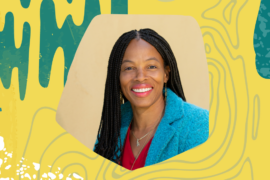Lifelong gardener Nan Sterman has lived many lives as a scientist, an instructional designer, and a journalist with bylines in Sunset and the Los Angeles Times, among many others. She’s the host of A Growing Passion, a TV show about gardening, an international speaker, and the leader of a Facebook group with tens of thousands of members.
Now, at Nan Sterman’s Garden School, she provides her students with a simple approach to starting seeds – one that anyone can do – to help them enjoy the bounty from their own gardens.
Today, Nan joins the podcast to share her journey to becoming a gardening expert, how her membership serves as a supplement to her existing businesses, and how to start a business that’s all about what you love and creates value for the people you serve.
Key Takeaways
- How watching her grandfather bite into a juicy, ripe tomato inspired Nan’s lifelong love of gardening.
- Why Nan felt like a fish out of water at a prestigious East Coast college – and how she found her people in botany class.
- Why it’s easier for Nan to have an impact on her audience when she calls herself a garden expert instead of a science teacher.
- How Nan’s interests converged through journalism, a TV show, and social media groups with explosive organic growth.
Free Give
FREE Guide – Launch & Grow a Profitable Membership Site
Ready to reclaim your time and attract more monthly paying customers? Our step-by-step guide will show you how to build a membership site that turns your passion into recurring profit. Click here to download!
Memorable Quote
- “I believe it’s possible to save the world through gardening.” – Nan Sterman
- “Writing a book is like giving birth. It takes longer, it’s more painful, it’s passive.” – Nan Sterman
Episode Resources
- Nan Sterman’s Garden School
- A Growing Passion
- Sunset Magazine
- Website: Waterwise Gardener
- Facebook Page: Nan Sterman, Waterwise Gardener
Transcript
Read The TranscriptShelli Varela: Nan Sterman, welcome to the It’s a TRIBE Thing podcast. How are you?
Nan Sterman: I’m great, Shelli. How are you?
Shelli Varela: I’m very good, well, because I am, but also because I’m just so excited to share your story. There are so many universal lessons in this. People are going to love it. You are fascinating. So, I’m looking forward to sharing you with our incredible audience, but I’ll start with, if you would mind, sharing who you are, what you do, and who you serve.
Nan Sterman: In essence, I’m a gardening expert. And I am a gardening expert who comes at gardening from a very science-based perspective because I want to do facts, not myths. And I serve a wide audience of people who are gardeners, want to be gardeners, primarily Southern California, because our climate here is very, very different from anywhere else. Gardening here is different from anywhere else in the world. And most of the information and most of the resources out there for people to find about gardening have nothing to do with where we are, it doesn’t apply at all.
Shelli Varela: It’s not a size fits all operation.
Nan Sterman: No. And gardening is extremely original, and our region is really unique. So, I’ve spent decades figuring this out. I’m born and raised in Southern California, though I’ve lived in other places. I’ve spent decades trying to figure this out and have been really successful. And now, I communicate how to be a better gardener, how to be successful to people who garden in this region. And gardening has been a thing forever, but especially, in the last couple of years, it’s totally exploded, much to my surprise. And I’m the right person in the right place at the right time.
Shelli Varela: Well, and also with the incredible right backstory, which I want to dive right into you. You talked about an incident when we were chatting earlier, and I can’t get the visual out of my head about your grandfather in the tomato plants. Can you take us back to there and just kind of share the breadcrumbs with us of how you ended up here, because your journey is so unique and it’s so curative of so many different, diverse things that came together to culminate with your membership site and your TV show and all of the amazing things you’re doing now?
Nan Sterman: Okay, so my earliest memory, one of my earliest memories, I had to have been no more than three years old, and I remember standing– my grandfather lived in an apartment. My grandparents lived in an apartment in Los Angeles, and we lived in a little house in Los Angeles right near the airport. And they didn’t have any place to grow anything. And my grandfather was a frustrated farmer, and so he used to come to our house every spring and he would plant a patch of tomatoes.
And my memory, it’s just a very vivid memory in my mind of standing on the tomato patch. So, as a little kid, the tomato plants were way overhead, like in a forest of tomatoes. And there’s a smell to tomato plants, they smell musty. And I think he probably used some pesticides, too, that had kind of a musty smell. I can still smell that, it’s still in my nasal passages. And I remember looking up through the foliage, and my grandfather, he had a stubbly face, he was a house painter. And so, he was not a clean-shaven person, but I remember him like biting into a big, ripe, juicy tomato and all the juice flowing down over the stubble and the look on his face of just satisfaction, like he was in heaven. It’s an indelible memory and I think it kind of set me on a path of appreciating and wanting to have that experience that I saw my grandfather have. So, that’s there for me.
Shelli Varela: So, where did you go? So, you started out as somebody who experienced this. And when I hear you recount it, I feel like I’m standing in the tomato plants also, but I can only imagine there was a certain type of connection or a certain emotional reaction because you have like 25 billion memories that you could call upon, but that one is seared in your mind for a reason.
Nan Sterman: Yeah.
Shelli Varela: So, what happened after that? What was the next step of you going to school? I know that you said you moved across the country. What did that for you?
Nan Sterman: So, I have that memory and I have the emotion of the memory. And I adored my grandfather. I was the favorite grandchild, I was the oldest. And I adored him and he adored me. And I grew up in Los Angeles and went to public school, all that stuff. And I had the unusual opportunity to go east to Duke University, which nobody even knew what Duke was in California at that time. It just happened to be that I got sent there, and I was supposed to study biomedical engineering, which I had no idea what that was. I eventually figured it out, it’s not me. And I was in an environment that was completely foreign to me. I’ve never been to North Carolina. I had never lived or been in that kind of an environment physically. The vegetation, the cold, all that stuff was totally foreign.
My fellow students were from New York or New Jersey and Connecticut, and they had all gone to private school. And there were some from North Carolina from the South, but not many. And I’m a public-school kid. I was like a fish out of water in every way. No one looked like me even. And I remember I felt very isolated and very alone. And at some point, I kind of noticed some of the students that looked a little bit like me. I mean, they were a little bit more like me and they were all going one place, like they were all walking this one path, like, where are those people going? And I followed them. They were going to the botany and zoology building. And I thought, oh, okay. And so, I signed up for a botany class. Like what made me think of that? I don’t know, they look like me.
Shelli Varela: I guess people like us do things like this.
Nan Sterman: I guess. I guess, I wasn’t a sorority person, a fraternity person. I thought that was ridiculous. I had grown up in an era where that was, like, not cool. I didn’t know they existed anymore. So, I got to take my first botany class like, oh, my God, this is wonderful. And I zoomed through the botany curriculum. And one of the things in those– when you take botany now, which is not as popular, it’s a lot of molecular stuff and cellular level stuff, but in those days, it was still a whole plant. So, like one of the great things that we used to do, I took a plant ID class. And a plant ID class was a graduate student taking, I don’t know, eight or ten undergraduates out into the Duke Forest in the fall after the leaves have fallen in an afternoon, and you would learn how to identify the trees and the shrubs like, oh, what kind of element is this, or what kind of maple is that or what kind of oak tree is this, blah, blah, blah, based on the little scar that’s left when the leaves fall off.
Shelli Varela: Wow.
Nan Sterman: Talk about obscure, but there was a reason for it. It taught me how to be observant, it taught me how to look very carefully and notice the minute differences between this plant and this plant, which also translates to noticing the differences in the rest of the world and observing the world. I didn’t realize that until many, many years later, but a lot of people look at plants, at gardens, at forest, natural areas, whatever, and they just see green or brown. I see, oh, there’s that oak and there’s that toon, and there’s that, I know all those things. They’re all familiar to me. I recognize them because I can see them.
It’s like people who read music. When you look at a sheet of music, if you don’t play an instrument, it just looks like a bunch of dots and lines, but if you play an instrument, you hear the music in your head, right? I do the same thing when I walk into a garden, when I walk into a natural area. Just by looking at what’s there, I can tell you what’s the sunlight here, what’s the drainage, what’s the temperature, who lives here, how did this go together, is it working, is it not working, it’s something that you develop over time, and it all is based in observing.
Shelli Varela: It’s such a beautiful through-line, right? It is because, like, I’m listening to you to recount the story and you’re talking about the connection originally with your grandfather and how you felt. And then when you play it forward, it’s like the gift of being present and observant in life in a way that is just atypical for sure, but even what you just said, the way that you can observe a plant and what it is and what type it is, but also how it is connected, just like you were connected in the garden as a little girl, how it’s connected to its environment and how it all fits together and how one thing can affect the next and how intrinsic and detailed it is, and the beauty that’s going on around you at any given moment and almost nobody notices.
Nan Sterman: Well, this is a really good point. One of the things that I teach my students is to look at the garden as a system. The garden is a system. All the components have to be there in order for the system to work. The soil, the water, the sunlight, the critters, the plants, it’s all a system. And if you break the system, you’re not going to have a successful garden. The same thing applies to the world around us. And this is why I do this, because the world, this is a system, the earth is a system, and we are slowly disassembling that system.
And so, what I don’t tell people is– I tell I’m a garden expert and a garden teacher, but I don’t tell them that I’m a science teacher because if I tell them I’m a science teacher, their eyes glaze over. If I tell them I’m a garden expert or garden teacher, there’s a million questions for me. I can teach them, I can help them understand to look at the world as a system and understand our role in it and what we do and how what we do impacts that system coming in through the garden door much more easily, much more easily than I could if I were a science teacher. There are a bunch of stickies on my computer, and one of them says, I believe, it’s possible to save the world through gardening.
Shelli Varela: So powerful, like it’s just such a universal lesson for the world as a whole, but also for people who are listening, who are thinking about maybe having a membership site. We’re going to talk about your TV show and your membership site, but I always say, like your story is a beautiful example of this and that you have all of these diverse interests. And many times, people will say, “Oh, well, I like knitting, and I like dogs and they don’t really go together.” And then all of a sudden, boom, membership site doing something like that. And I think it’s brilliant how you have paid attention to what is a yes for you and what is not this, even if you don’t know what it is, hmmm, but not this.
Nan Sterman: Well, I’ve tried a lot of things that turned out to be not this, too.
Shelli Varela: Right, but I love your intuition in the way you follow and pay attention to what your body is telling you as well. So, can you tell us about your TV show, and how you came to have a membership site?
Nan Sterman: Okay. So, I went to university, I went to graduate school to become a scientist, I was not successful. That was a no, but I realized that I was really passionate talking about science and teaching about science and being with people and opening their eyes to the universe. And so, I started going in the direction of science communications and became a science journalist, and writing about science and research and all that kind of stuff. And then, I ended up going back to university, getting a second graduate degree at an area called Instructional Design. Instructional design is all about creating training programs and curricula and education programs, the things that classroom teachers do, but also, if you work for a company and there’s a new product introduced, somebody has to create the instruction so you learn that.
I worked for the Getty Art Institute. I did work for this, too. I work in industry. I get all kinds of things. It didn’t matter what the content was, it was the process. And then, at some point, the instructional design and the gardening and the science intersected, I became a garden journalist. And I did that, I wrote about gardening. I’m a very curious person, so I’m really good at it. Like you, I ask questions and it’s like when you’re in the journalist seat, you can ask questions so other people can answer. You could ask questions that other people would just never have the comfort to do, or the person you’re talking to would never feel comfortable answering them.
So, I started interviewing people. I started writing about things that interested me. And I wrote, I was the garden editor for the Home Garden magazine. I’ve written for newspapers, magazines, many, many you would know. And I was on the radio, started giving talks, all that kind of stuff. And at some point, I have done some television and at some point, I realized no matter how good I was at writing about things or taking pictures, there’s nothing like seeing someone’s face talk about their passion for their garden.
And so, I had the idea that I wanted to do a TV show, going to visit people’s gardens and showing that as a way of inspiring people and showing them what they could do in their gardens. So, I started that whole idea in 2003. And it took 10 years to get it going. By the time, it actually happened, it was a whole different format. My TV show was called A Growing Passion. The passion is my passion for plants, and it’s much more than gardens. I take people anywhere plants grow and open their eyes to what opportunities there are.
So, this season, we’re in season 8. We just finished shooting show 48. And we have been to the desert and we’ve been to the mountains. And we followed wildflower blooms. And we’ve been in people’s backyards and we’ve been on farms and the giant trees in California. We did an episode on how water reaches, because water is a big issue in our state, not where you are, how water travels hundreds of miles to get to where we are to be able to use it in our garden. We water our gardens with drinking water. That’s a crazy concept, but we do.
I have met people who breed seeds and who breed fruit trees. And you never think about when you go to the nursery, you pick out that little pack of seeds in the nursery. How did it get there? When did it start? What was the trail? How many people touch that seed? How many varieties will never come to market for that one, fruit trees? It’s amazing. The whole process is amazing.
Shelli Varela: Well, I love that you’re a secret weapon also because you are smart enough to know that the thing people think they’re interested in, and they are, is gardening, but your science brain behind it is bringing them stuff that they don’t even know they don’t know.
Nan Sterman: Exactly. That’s exactly right. So, I have a Facebook group that I started in 2014 just for my county, just San Diego County, San Diego gardener. We’re at 14,000 people, just in however many years that is, never promoted, just total organic growth. We could be twice that, but we’re picky about who we let in. You’ve got to answer those screening questions or else we don’t let you in. And I started thinking, I get asked questions all the time about gardening and I get asked the same questions, and I thought, okay, if there’s one person who has that question, there’s a hundred, there’s a thousand. Let’s start this. I can answer questions, and there’ll be a place for people to go.
Well, when it exploded, we had all these other experts in other arenas. So, it’s like a whole group. I mean, we’re talking about topics that are timely all the time. We have a guy who’s an insect expert, someone who’s a farmer. We have someone who is an expert in making wines and managing grapes. We have just succulents and plumeria, all the stuff. So, everyone gets in the sandbox and it’s really wonderful. So, we’ve got that going.
In the meantime, the world of journalism is collapsing. It’s collapsing. Those magazines and newspapers that I’ve written for, either they don’t exist or exist as a tale form of their former selves. So, I don’t have that outlet to be able to write long forms about someone’s garden or whatever and…
Shelli Varela: And yet, you know that people wanted and needed and are asking for it.
Nan Sterman: Yes. And I’m driven to do it, I’m totally driven to do it. So, I’ve got the TV show, I’ve got the Facebook group, I’ve got talks. I take people around the world and international garden tours. Every year, we go on a garden tour somewhere in the world. I do all these different things. I write books, but I didn’t want to write another book. Writing a book is like giving birth. It takes longer, it’s more painful, it’s passive. If you write a book, it gets put on a shelf or maybe it’s on Amazon or whatever it is. Somebody has to buy it. Then they have to open it. Then they have to read it. The number of games starts to get really, really small, and there’s no interaction. I can’t be talking to them, I can’t help them, I can’t respond to their questions.
And so, at some point, I thought, I’m going to go online and I’m going to start creating online courses. And that took me into a path and I discovered TRIBE, and that sort of helped me focus my thinking. And what I finally came down to was deciding that I needed to create– I wasn’t going to do a membership, I’m going to do online courses, but I realized that a membership gives me the opportunity to have ongoing interactions. So, Nan Sterman’s Garden School, I thought I would come up with some clever name for it, but every time I talk to anybody about it, it just comes back to garden school. This is garden school.
So, Nan Sterman’s Garden School has two components to it. One is stand-alone classes that are like somebody signing up for one time they do it and they’re done with it, and then there’s a membership. And the membership is monthly annual. So, I’ve been working on this since before the pandemic. The pandemic for me actually was kind of a blessing because it gave me– for a couple of months, nobody was working on gardens. I design gardens. That’s my bread and butter. Nobody was doing that, and we were just sitting home. And so, I could really focus on, okay, what do I want this to be? And how do I want it to look? And how am I going to do this?
So, the membership is launched. I started a founding member launch six months ago. And I’m just about to open the doors on the whole big shebang. So, the vision is every week, people get something. At the beginning of the month, they get a list of what to do in the garden this month. Nobody knows what to do in the garden. They’re always like, what should I be doing now? What should I be doing now? Okay, here’s your list.
Shelli Varela: Yeah. And ask Nan, she knows.
Nan Sterman: Yeah, really, honestly. Like yeah, I’ve been writing these what-to-dos in the garden list for 20 years. I wrote them for Sunset magazine. I write them for the L.A. Times. I write them for my local newspaper. I’ve written them for other publications. I have all this content. I have a huge treasure trove of content. In addition to that, all the people that I’ve interviewed over the years have been so generous with the information they had, whether they were experts in bamboo or cactus or agave or fruit trees, whatever, it’s all in my computer, in my head. It’s my job, it’s my obligation now to pass that on because what good is it sitting in my head and on my computer?
Shelli Varela: Well, the thing that I see is such a huge gift about for people like you is you have such a diverse interest base and curiosity and also have just been so true to what is a yes and what is a not this for you, which has allowed you to sort of cartwheel through and land in this incredible position with these wild experiences and meeting so many different people that have expertise in different areas, like you said, different plant life or whatever that looks like, but the advantage that people get by joining your membership is they get to take advantage of your connection about your background, about your science, about your curiosity, about what all of it means. And it’s just such a brilliant way to bring a membership site.
And for those who are starting a membership, it’s also a way to just birth that which you love, that what you’re probably thinking about and doing anyway. And so, I want to offer this to anybody listening, if you’re looking for a way to reach, then what is the best place they can connect with you online?
Nan Sterman: My website is WaterwiseGardener.com, and you can go there and there’s five different places where it says Contact Nan, Send Nan a Note, Find Nan, just send me an email through my website.
Shelli Varela: Brilliant.
Nan Sterman: And that’s where– so, let me just tell you though, there’s Nan Sterman’s Garden School, and I just launched about a month ago my first online standalone, which is a seed starting workshop that I’ve taught in person for 10 years. And I had to figure out how to translate it to digital. It’s sold out. I had enough supplies, going to have to send some of the supplies. I had 60 spots. It sold out in 12 hours.
Shelli Varela: Wow.
Nan Sterman: I’ve just restocked, I’m going to open it up again either later today or tomorrow for another 40 spots. All the work is done. So, now, anybody else who signs up, it just helps me pay back for my investment.
Shelli Varela: I love it. Thank you for stopping by and sharing about your story and your connection and stepping outside your comfort zone and paying attention to your intuition and being present and observant. And these are all lessons that we always need reminding of, and thank you for sharing yours.
Nan Sterman: Thank you so much for asking.
[END]
To learn more and get access to all episodes, visit our podcast page!
